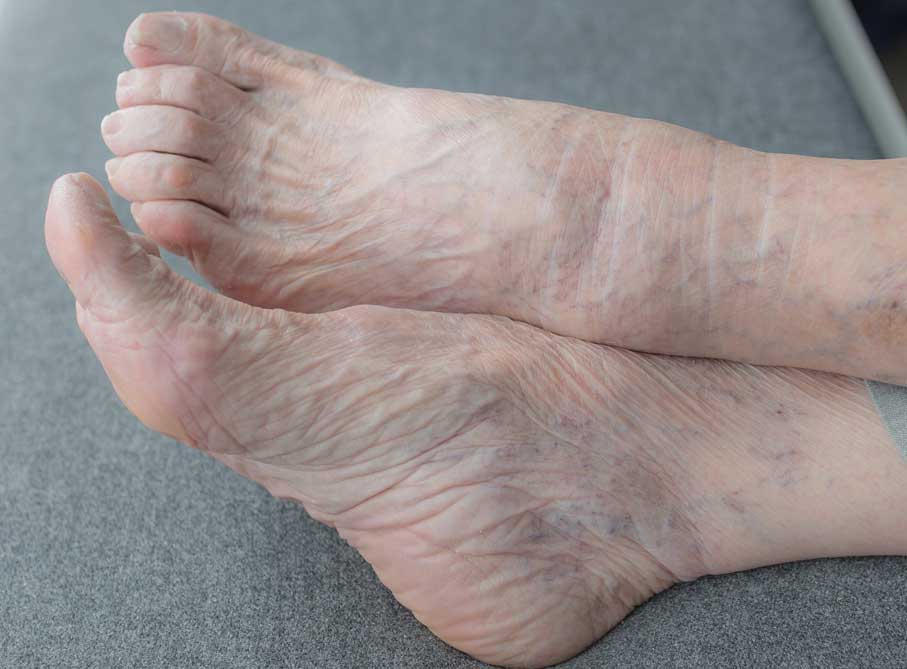Aging Feet
A lot can be done to relieve pain and improve comfort and maintain your quality of life as you get older.

by 80 years of age, you may have walked the distance of around the earth 5 times!
A lot can be done to relieve pain
Did you know that the average person takes around 7500 steps a day and that by the time they are 80 years of age, they have walked the equivalent of 5 times around the earth along the equator? It’s no wonder then that we often get more foot problems as we get older. However, painful and uncomfortable feet are not something that you just have to “put up with”.
A lot can be done to relieve pain, improve comfort and maintain your quality of life as you get older.
Feet reflect your general health
The condition of our feet often provides an early indicator for conditions such as diabetes, arthritis and circulatory disease. Look out for signs of dry skin, brittle nails, burning or tingling sensations, coldness, numbness, swelling or discolouration. If you notice any of these occurring you should call for an appointment at Armadale Podiatry.
Many people, including older people believe its normal for feet to hurt, and simply resign themselves to enduring foot problems which can be treated. There are more than 300 different foot conditions, some are inherited, but for older people, most stem from the impact of years of use. However, many foot problems can be successfully managed and the pain of foot conditions relieved.
Mind your weight
As we age, our feet tend to spread and lose the fatty pads that cushion the bottom of the feet. This can lead to problems of callus formation under the balls of the feet and corns appearing on the toes. Older people should have their feet measured for shoe size more frequently, rather than presuming that their shoe sizes remain constant, to accommodate these changes. If we are carrying extra weight, this can also affect the bone and ligament structure and adds extra pressure to the muscles of the legs and feet.
Keeping Active
Taking good care of your feet has many benefits including increasing your comfort, limiting the possibility of additional medical problems, reducing your chance of hospitalizations due to infections and keeping you active and mobile.
Mobility can be a problem for older people, yet with basic foot care, and prompt attention to any problems as they arise, staying on your feet shouldn’t be a problem.
Foot Health Tips
Shoes: Properly fitted shoes are essential. The older you get, the more you need a shoe that holds your foot firmly in place and gives adequate support which means your worn out “old favourites” should be thrown out before they cause problems. A shoe with a firm sole and supportive upper is the best for daily activities.
Socks: Socks and stockings should be the correct size for your feet and preferably free from seams which may lead to irritation on the toes. Socks higher in cotton, bamboo or natural fibres will absorb more sweat and reduce the chance of moist, smelly feet and shoes. Also check that the tops of the socks are not too tight and restrict circulation in your legs. If you see the indent of the top of the socks in your legs after taking off them off, you may need to look for socks that accommodate swelling in the legs, such as Diabetic socks or All Day socks.
Corns and calluses: Corns are best treated by a podiatrist as many of the “off the shelf” products can do more harm than good. A pumice stone is good to use around the heels in your daily shower to keep rough heels and callus at bay.
Applying daily moisturiser is also recommended to keep the skin soft and reduce the thickness of callus.
Nails: Trim your nails regularly so they are slightly curved just sort of the end of your toe. Avoid cutting down the sides of the nails, as this tends to result in small spicules of nails being left behind which then grow into the toe sulci and result in an ingrown toenail. If this happens, contact Armadale Podiatry for an appointment to remove the spicule of nail for you. If you find cutting toenails a problem due to poor eyesight or difficulties in bending down or bending your legs, then it is advisable to visit a podiatrist every 8-10 weeks for regular nail maintenance.
Know what is normal for your feet:
Inspect your feet daily or have someone do this for you. Sometimes, a small mirror on the floor or special mirrors on extendable arms are also useful to help you see the bottoms of your feet if you have problems reaching them.
If you notice any redness, cracks in the skin or sores, consult with your podiatrist as soon as possible. Even if you are not having any major problems with your feet, it is recommended that you should have your feet checked by a podiatrist at least once a year.
Contact us
Ask a question or request an appointment below.
For emergencies call 000 or visit your nearest hospital
